The Limitations of Online Recruitment Strategies in Corporation
VerifiedAdded on 2019/11/08
|15
|3853
|186
Report
AI Summary
The provided content discusses the effectiveness of social media in recruitment processes. Many corporations currently use online strategies due to its benefits such as wider reach, less expensive and targeting specific candidates. However, it also presents drawbacks like receiving a large number of applications from candidates which makes it difficult for human resources management to evaluate and the risk of hacking or scamming of data from cyber criminals. To avoid giving any unfair advantage to certain people, companies should implement offline methods of recruitment.
Contribute Materials
Your contribution can guide someone’s learning journey. Share your
documents today.
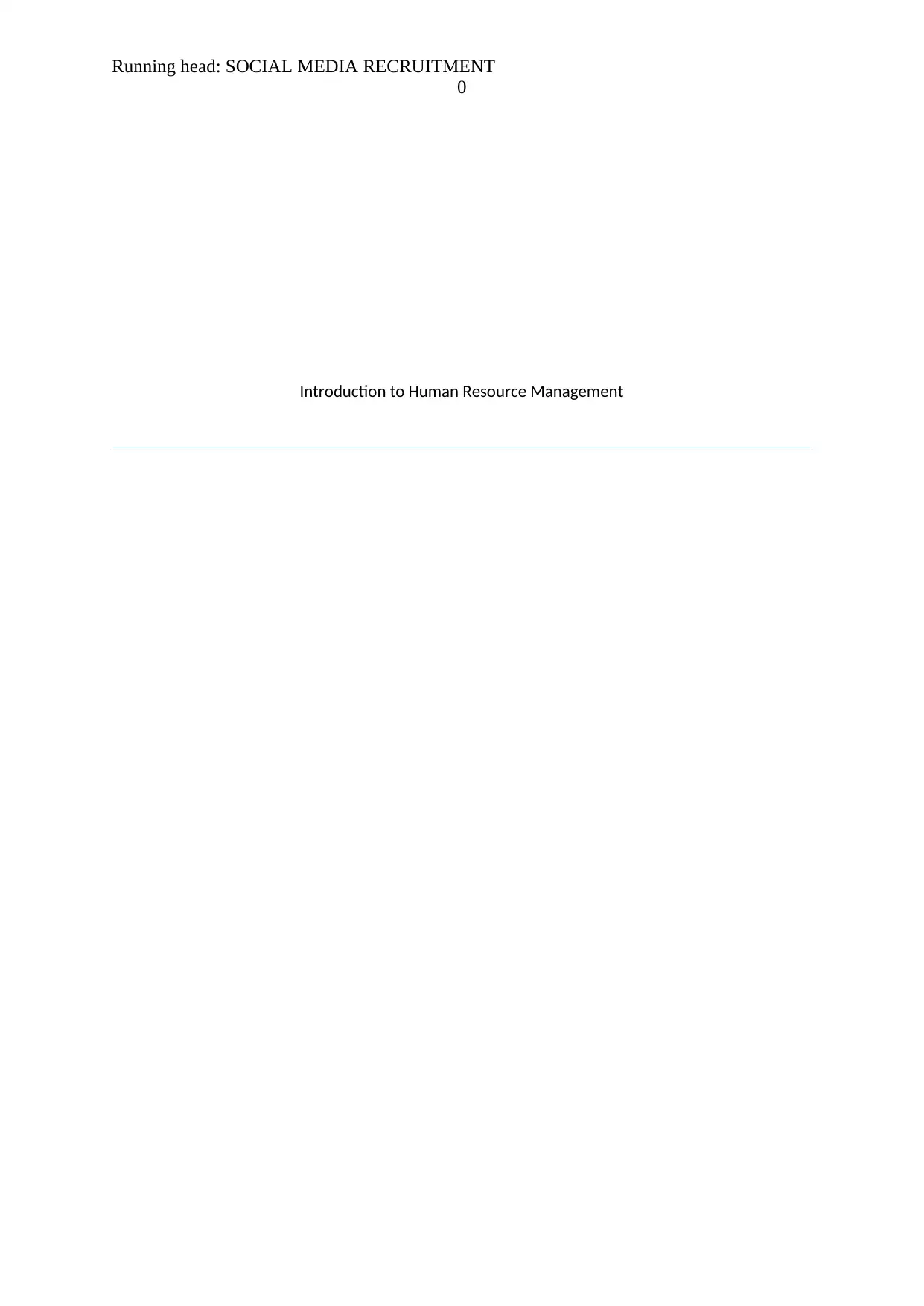
Running head: SOCIAL MEDIA RECRUITMENT
0
Introduction to Human Resource Management
0
Introduction to Human Resource Management
Secure Best Marks with AI Grader
Need help grading? Try our AI Grader for instant feedback on your assignments.
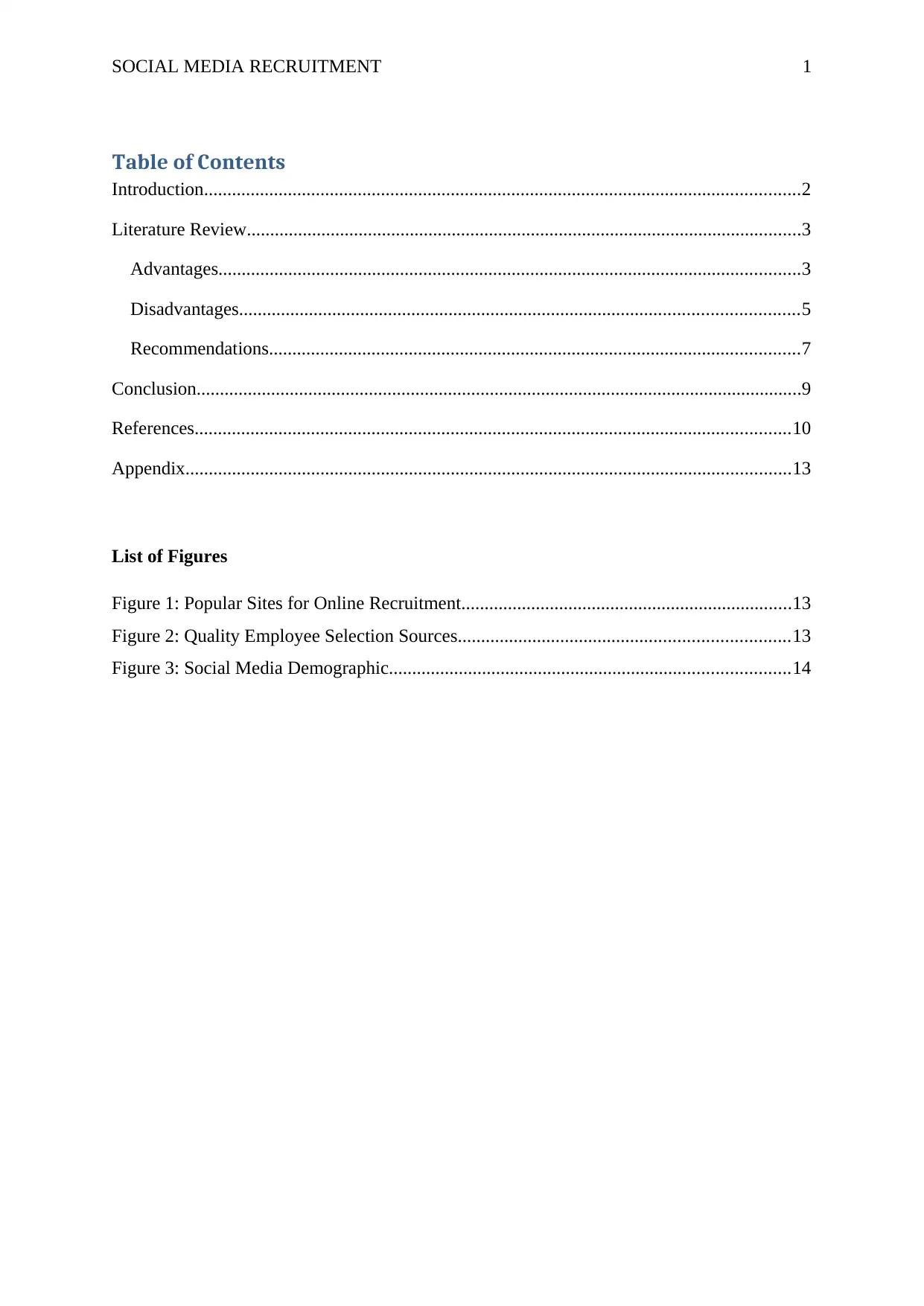
SOCIAL MEDIA RECRUITMENT 1
Table of Contents
Introduction................................................................................................................................2
Literature Review.......................................................................................................................3
Advantages.............................................................................................................................3
Disadvantages........................................................................................................................5
Recommendations..................................................................................................................7
Conclusion..................................................................................................................................9
References................................................................................................................................10
Appendix..................................................................................................................................13
List of Figures
Figure 1: Popular Sites for Online Recruitment.......................................................................13
Figure 2: Quality Employee Selection Sources.......................................................................13
Figure 3: Social Media Demographic......................................................................................14
Table of Contents
Introduction................................................................................................................................2
Literature Review.......................................................................................................................3
Advantages.............................................................................................................................3
Disadvantages........................................................................................................................5
Recommendations..................................................................................................................7
Conclusion..................................................................................................................................9
References................................................................................................................................10
Appendix..................................................................................................................................13
List of Figures
Figure 1: Popular Sites for Online Recruitment.......................................................................13
Figure 2: Quality Employee Selection Sources.......................................................................13
Figure 3: Social Media Demographic......................................................................................14
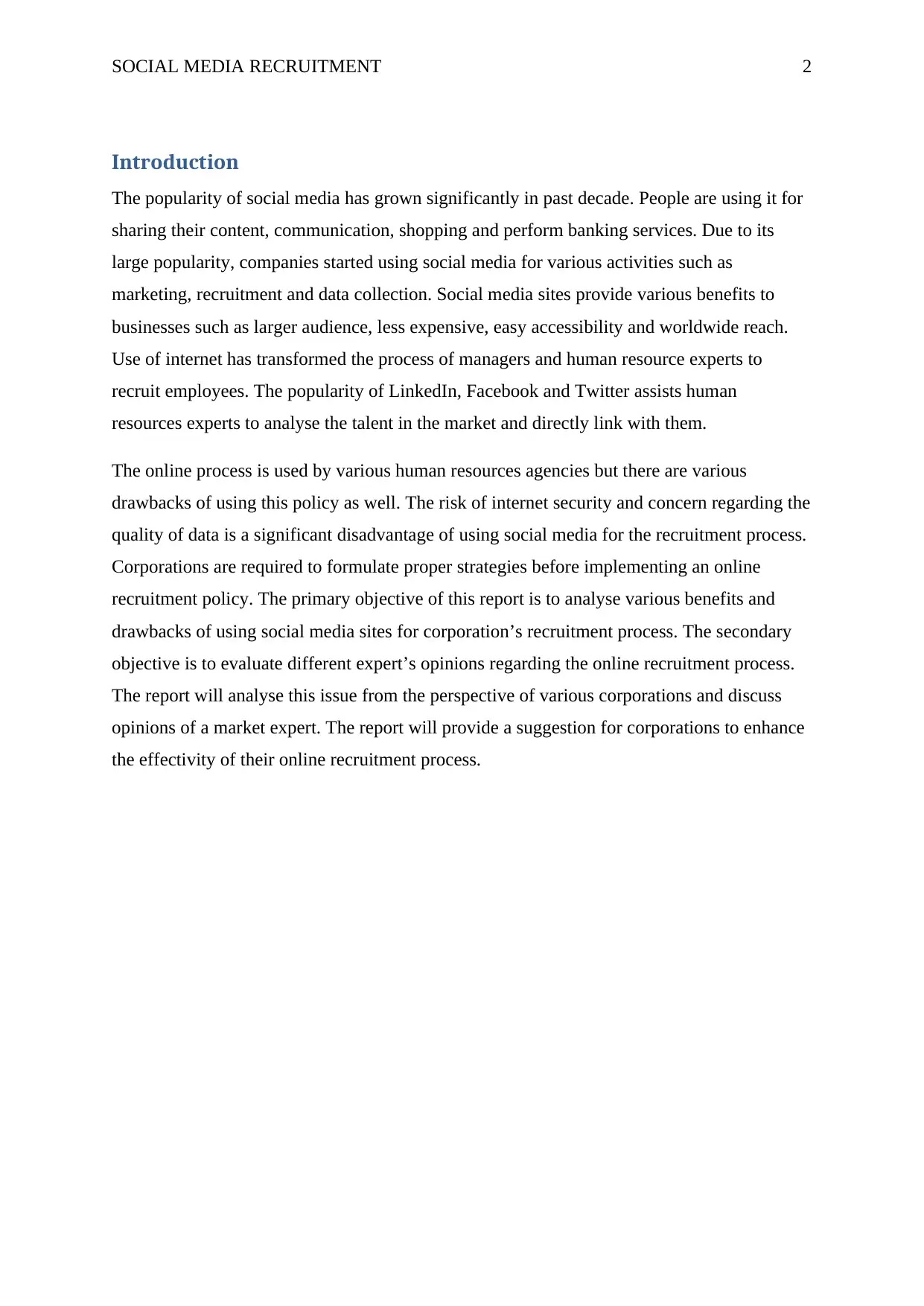
SOCIAL MEDIA RECRUITMENT 2
Introduction
The popularity of social media has grown significantly in past decade. People are using it for
sharing their content, communication, shopping and perform banking services. Due to its
large popularity, companies started using social media for various activities such as
marketing, recruitment and data collection. Social media sites provide various benefits to
businesses such as larger audience, less expensive, easy accessibility and worldwide reach.
Use of internet has transformed the process of managers and human resource experts to
recruit employees. The popularity of LinkedIn, Facebook and Twitter assists human
resources experts to analyse the talent in the market and directly link with them.
The online process is used by various human resources agencies but there are various
drawbacks of using this policy as well. The risk of internet security and concern regarding the
quality of data is a significant disadvantage of using social media for the recruitment process.
Corporations are required to formulate proper strategies before implementing an online
recruitment policy. The primary objective of this report is to analyse various benefits and
drawbacks of using social media sites for corporation’s recruitment process. The secondary
objective is to evaluate different expert’s opinions regarding the online recruitment process.
The report will analyse this issue from the perspective of various corporations and discuss
opinions of a market expert. The report will provide a suggestion for corporations to enhance
the effectivity of their online recruitment process.
Introduction
The popularity of social media has grown significantly in past decade. People are using it for
sharing their content, communication, shopping and perform banking services. Due to its
large popularity, companies started using social media for various activities such as
marketing, recruitment and data collection. Social media sites provide various benefits to
businesses such as larger audience, less expensive, easy accessibility and worldwide reach.
Use of internet has transformed the process of managers and human resource experts to
recruit employees. The popularity of LinkedIn, Facebook and Twitter assists human
resources experts to analyse the talent in the market and directly link with them.
The online process is used by various human resources agencies but there are various
drawbacks of using this policy as well. The risk of internet security and concern regarding the
quality of data is a significant disadvantage of using social media for the recruitment process.
Corporations are required to formulate proper strategies before implementing an online
recruitment policy. The primary objective of this report is to analyse various benefits and
drawbacks of using social media sites for corporation’s recruitment process. The secondary
objective is to evaluate different expert’s opinions regarding the online recruitment process.
The report will analyse this issue from the perspective of various corporations and discuss
opinions of a market expert. The report will provide a suggestion for corporations to enhance
the effectivity of their online recruitment process.
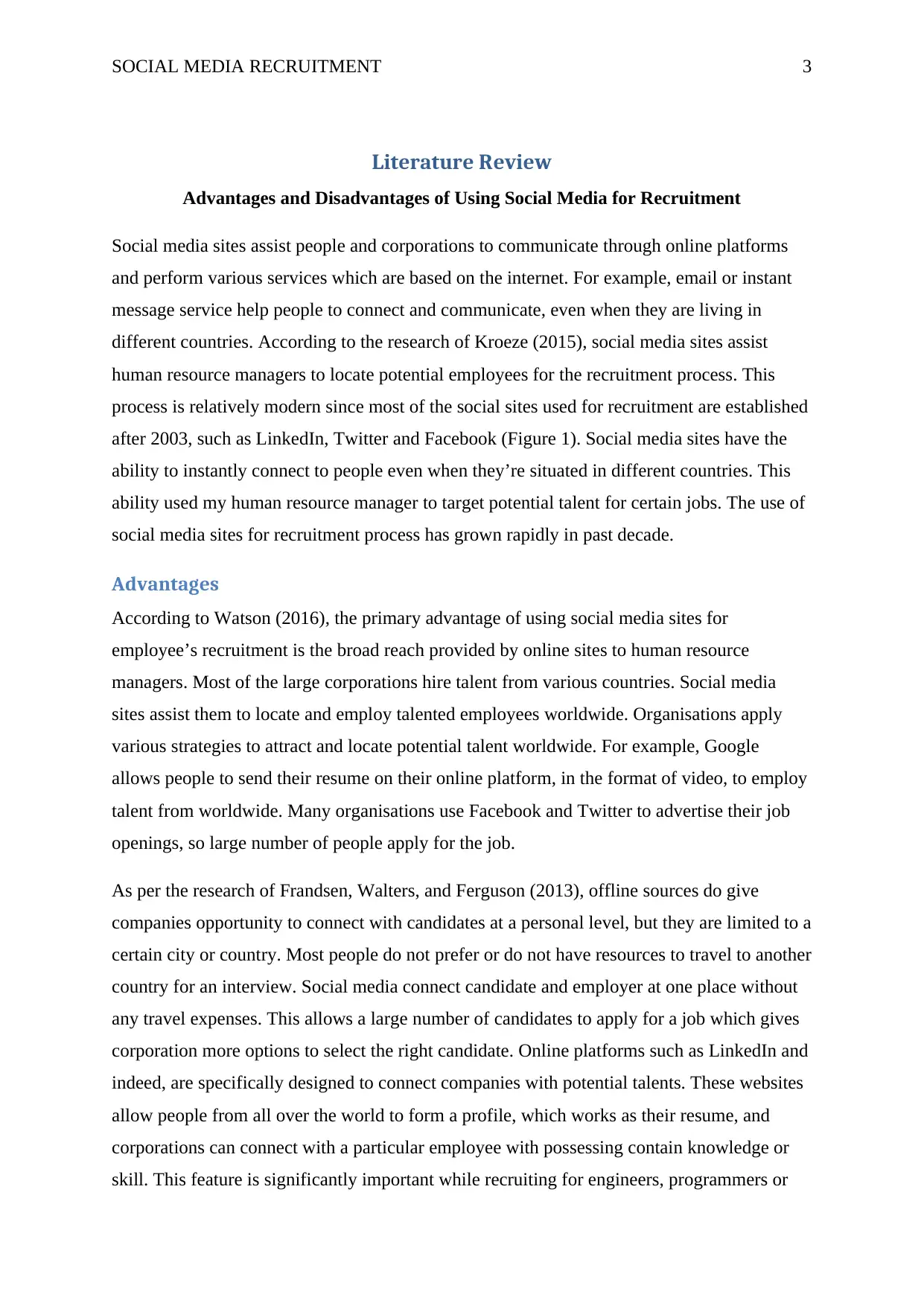
SOCIAL MEDIA RECRUITMENT 3
Literature Review
Advantages and Disadvantages of Using Social Media for Recruitment
Social media sites assist people and corporations to communicate through online platforms
and perform various services which are based on the internet. For example, email or instant
message service help people to connect and communicate, even when they are living in
different countries. According to the research of Kroeze (2015), social media sites assist
human resource managers to locate potential employees for the recruitment process. This
process is relatively modern since most of the social sites used for recruitment are established
after 2003, such as LinkedIn, Twitter and Facebook (Figure 1). Social media sites have the
ability to instantly connect to people even when they’re situated in different countries. This
ability used my human resource manager to target potential talent for certain jobs. The use of
social media sites for recruitment process has grown rapidly in past decade.
Advantages
According to Watson (2016), the primary advantage of using social media sites for
employee’s recruitment is the broad reach provided by online sites to human resource
managers. Most of the large corporations hire talent from various countries. Social media
sites assist them to locate and employ talented employees worldwide. Organisations apply
various strategies to attract and locate potential talent worldwide. For example, Google
allows people to send their resume on their online platform, in the format of video, to employ
talent from worldwide. Many organisations use Facebook and Twitter to advertise their job
openings, so large number of people apply for the job.
As per the research of Frandsen, Walters, and Ferguson (2013), offline sources do give
companies opportunity to connect with candidates at a personal level, but they are limited to a
certain city or country. Most people do not prefer or do not have resources to travel to another
country for an interview. Social media connect candidate and employer at one place without
any travel expenses. This allows a large number of candidates to apply for a job which gives
corporation more options to select the right candidate. Online platforms such as LinkedIn and
indeed, are specifically designed to connect companies with potential talents. These websites
allow people from all over the world to form a profile, which works as their resume, and
corporations can connect with a particular employee with possessing contain knowledge or
skill. This feature is significantly important while recruiting for engineers, programmers or
Literature Review
Advantages and Disadvantages of Using Social Media for Recruitment
Social media sites assist people and corporations to communicate through online platforms
and perform various services which are based on the internet. For example, email or instant
message service help people to connect and communicate, even when they are living in
different countries. According to the research of Kroeze (2015), social media sites assist
human resource managers to locate potential employees for the recruitment process. This
process is relatively modern since most of the social sites used for recruitment are established
after 2003, such as LinkedIn, Twitter and Facebook (Figure 1). Social media sites have the
ability to instantly connect to people even when they’re situated in different countries. This
ability used my human resource manager to target potential talent for certain jobs. The use of
social media sites for recruitment process has grown rapidly in past decade.
Advantages
According to Watson (2016), the primary advantage of using social media sites for
employee’s recruitment is the broad reach provided by online sites to human resource
managers. Most of the large corporations hire talent from various countries. Social media
sites assist them to locate and employ talented employees worldwide. Organisations apply
various strategies to attract and locate potential talent worldwide. For example, Google
allows people to send their resume on their online platform, in the format of video, to employ
talent from worldwide. Many organisations use Facebook and Twitter to advertise their job
openings, so large number of people apply for the job.
As per the research of Frandsen, Walters, and Ferguson (2013), offline sources do give
companies opportunity to connect with candidates at a personal level, but they are limited to a
certain city or country. Most people do not prefer or do not have resources to travel to another
country for an interview. Social media connect candidate and employer at one place without
any travel expenses. This allows a large number of candidates to apply for a job which gives
corporation more options to select the right candidate. Online platforms such as LinkedIn and
indeed, are specifically designed to connect companies with potential talents. These websites
allow people from all over the world to form a profile, which works as their resume, and
corporations can connect with a particular employee with possessing contain knowledge or
skill. This feature is significantly important while recruiting for engineers, programmers or
Secure Best Marks with AI Grader
Need help grading? Try our AI Grader for instant feedback on your assignments.
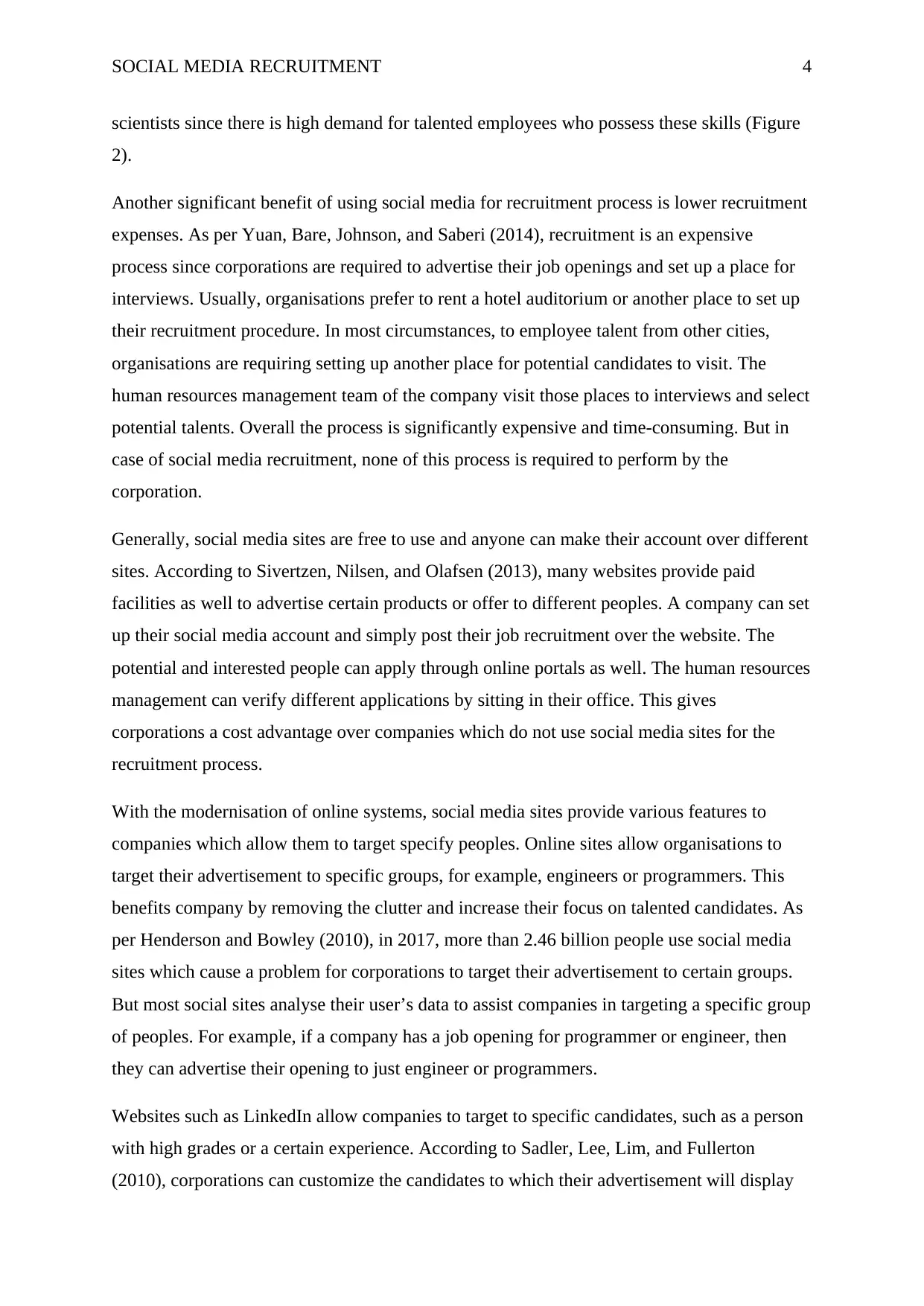
SOCIAL MEDIA RECRUITMENT 4
scientists since there is high demand for talented employees who possess these skills (Figure
2).
Another significant benefit of using social media for recruitment process is lower recruitment
expenses. As per Yuan, Bare, Johnson, and Saberi (2014), recruitment is an expensive
process since corporations are required to advertise their job openings and set up a place for
interviews. Usually, organisations prefer to rent a hotel auditorium or another place to set up
their recruitment procedure. In most circumstances, to employee talent from other cities,
organisations are requiring setting up another place for potential candidates to visit. The
human resources management team of the company visit those places to interviews and select
potential talents. Overall the process is significantly expensive and time-consuming. But in
case of social media recruitment, none of this process is required to perform by the
corporation.
Generally, social media sites are free to use and anyone can make their account over different
sites. According to Sivertzen, Nilsen, and Olafsen (2013), many websites provide paid
facilities as well to advertise certain products or offer to different peoples. A company can set
up their social media account and simply post their job recruitment over the website. The
potential and interested people can apply through online portals as well. The human resources
management can verify different applications by sitting in their office. This gives
corporations a cost advantage over companies which do not use social media sites for the
recruitment process.
With the modernisation of online systems, social media sites provide various features to
companies which allow them to target specify peoples. Online sites allow organisations to
target their advertisement to specific groups, for example, engineers or programmers. This
benefits company by removing the clutter and increase their focus on talented candidates. As
per Henderson and Bowley (2010), in 2017, more than 2.46 billion people use social media
sites which cause a problem for corporations to target their advertisement to certain groups.
But most social sites analyse their user’s data to assist companies in targeting a specific group
of peoples. For example, if a company has a job opening for programmer or engineer, then
they can advertise their opening to just engineer or programmers.
Websites such as LinkedIn allow companies to target to specific candidates, such as a person
with high grades or a certain experience. According to Sadler, Lee, Lim, and Fullerton
(2010), corporations can customize the candidates to which their advertisement will display
scientists since there is high demand for talented employees who possess these skills (Figure
2).
Another significant benefit of using social media for recruitment process is lower recruitment
expenses. As per Yuan, Bare, Johnson, and Saberi (2014), recruitment is an expensive
process since corporations are required to advertise their job openings and set up a place for
interviews. Usually, organisations prefer to rent a hotel auditorium or another place to set up
their recruitment procedure. In most circumstances, to employee talent from other cities,
organisations are requiring setting up another place for potential candidates to visit. The
human resources management team of the company visit those places to interviews and select
potential talents. Overall the process is significantly expensive and time-consuming. But in
case of social media recruitment, none of this process is required to perform by the
corporation.
Generally, social media sites are free to use and anyone can make their account over different
sites. According to Sivertzen, Nilsen, and Olafsen (2013), many websites provide paid
facilities as well to advertise certain products or offer to different peoples. A company can set
up their social media account and simply post their job recruitment over the website. The
potential and interested people can apply through online portals as well. The human resources
management can verify different applications by sitting in their office. This gives
corporations a cost advantage over companies which do not use social media sites for the
recruitment process.
With the modernisation of online systems, social media sites provide various features to
companies which allow them to target specify peoples. Online sites allow organisations to
target their advertisement to specific groups, for example, engineers or programmers. This
benefits company by removing the clutter and increase their focus on talented candidates. As
per Henderson and Bowley (2010), in 2017, more than 2.46 billion people use social media
sites which cause a problem for corporations to target their advertisement to certain groups.
But most social sites analyse their user’s data to assist companies in targeting a specific group
of peoples. For example, if a company has a job opening for programmer or engineer, then
they can advertise their opening to just engineer or programmers.
Websites such as LinkedIn allow companies to target to specific candidates, such as a person
with high grades or a certain experience. According to Sadler, Lee, Lim, and Fullerton
(2010), corporations can customize the candidates to which their advertisement will display
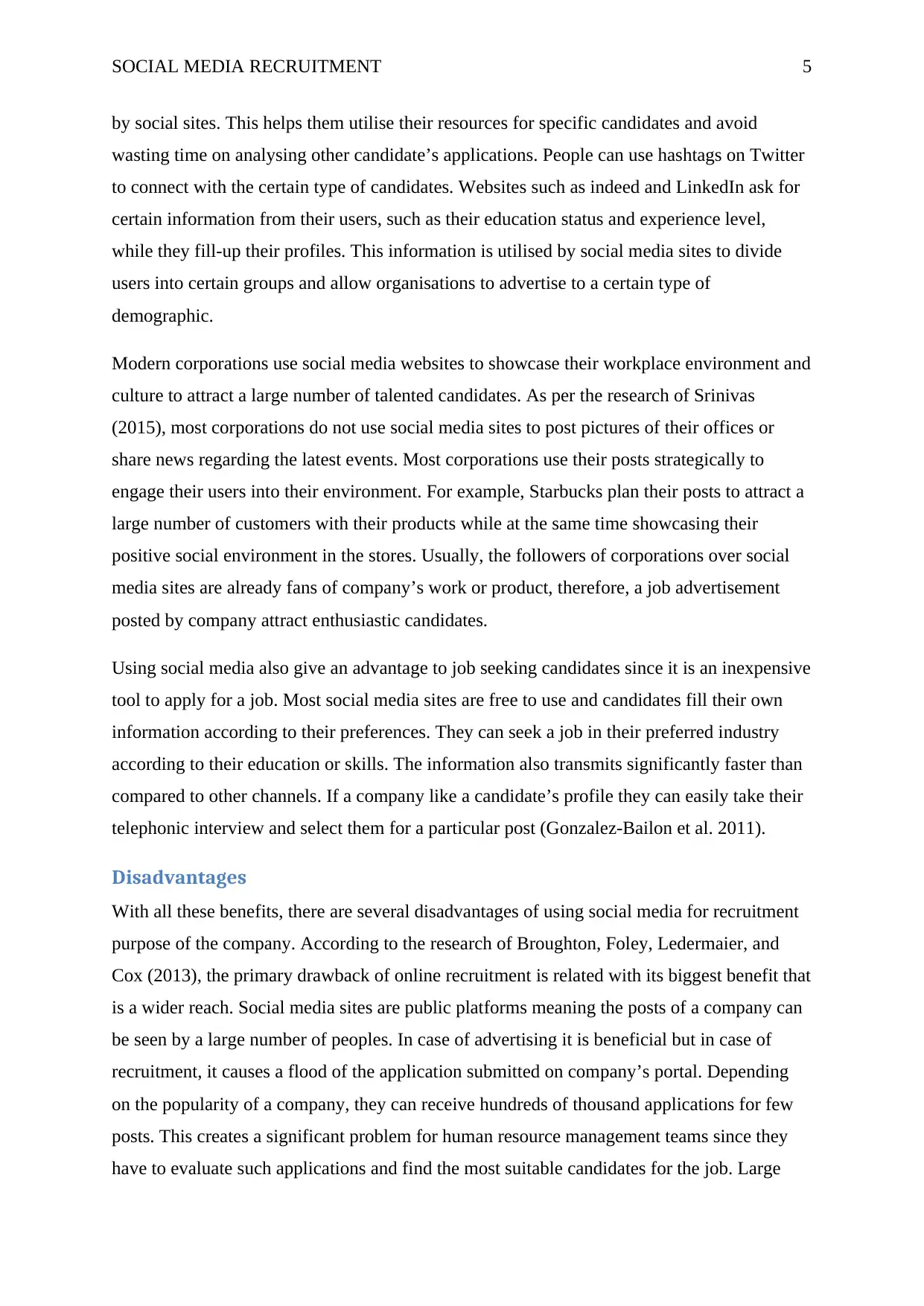
SOCIAL MEDIA RECRUITMENT 5
by social sites. This helps them utilise their resources for specific candidates and avoid
wasting time on analysing other candidate’s applications. People can use hashtags on Twitter
to connect with the certain type of candidates. Websites such as indeed and LinkedIn ask for
certain information from their users, such as their education status and experience level,
while they fill-up their profiles. This information is utilised by social media sites to divide
users into certain groups and allow organisations to advertise to a certain type of
demographic.
Modern corporations use social media websites to showcase their workplace environment and
culture to attract a large number of talented candidates. As per the research of Srinivas
(2015), most corporations do not use social media sites to post pictures of their offices or
share news regarding the latest events. Most corporations use their posts strategically to
engage their users into their environment. For example, Starbucks plan their posts to attract a
large number of customers with their products while at the same time showcasing their
positive social environment in the stores. Usually, the followers of corporations over social
media sites are already fans of company’s work or product, therefore, a job advertisement
posted by company attract enthusiastic candidates.
Using social media also give an advantage to job seeking candidates since it is an inexpensive
tool to apply for a job. Most social media sites are free to use and candidates fill their own
information according to their preferences. They can seek a job in their preferred industry
according to their education or skills. The information also transmits significantly faster than
compared to other channels. If a company like a candidate’s profile they can easily take their
telephonic interview and select them for a particular post (Gonzalez-Bailon et al. 2011).
Disadvantages
With all these benefits, there are several disadvantages of using social media for recruitment
purpose of the company. According to the research of Broughton, Foley, Ledermaier, and
Cox (2013), the primary drawback of online recruitment is related with its biggest benefit that
is a wider reach. Social media sites are public platforms meaning the posts of a company can
be seen by a large number of peoples. In case of advertising it is beneficial but in case of
recruitment, it causes a flood of the application submitted on company’s portal. Depending
on the popularity of a company, they can receive hundreds of thousand applications for few
posts. This creates a significant problem for human resource management teams since they
have to evaluate such applications and find the most suitable candidates for the job. Large
by social sites. This helps them utilise their resources for specific candidates and avoid
wasting time on analysing other candidate’s applications. People can use hashtags on Twitter
to connect with the certain type of candidates. Websites such as indeed and LinkedIn ask for
certain information from their users, such as their education status and experience level,
while they fill-up their profiles. This information is utilised by social media sites to divide
users into certain groups and allow organisations to advertise to a certain type of
demographic.
Modern corporations use social media websites to showcase their workplace environment and
culture to attract a large number of talented candidates. As per the research of Srinivas
(2015), most corporations do not use social media sites to post pictures of their offices or
share news regarding the latest events. Most corporations use their posts strategically to
engage their users into their environment. For example, Starbucks plan their posts to attract a
large number of customers with their products while at the same time showcasing their
positive social environment in the stores. Usually, the followers of corporations over social
media sites are already fans of company’s work or product, therefore, a job advertisement
posted by company attract enthusiastic candidates.
Using social media also give an advantage to job seeking candidates since it is an inexpensive
tool to apply for a job. Most social media sites are free to use and candidates fill their own
information according to their preferences. They can seek a job in their preferred industry
according to their education or skills. The information also transmits significantly faster than
compared to other channels. If a company like a candidate’s profile they can easily take their
telephonic interview and select them for a particular post (Gonzalez-Bailon et al. 2011).
Disadvantages
With all these benefits, there are several disadvantages of using social media for recruitment
purpose of the company. According to the research of Broughton, Foley, Ledermaier, and
Cox (2013), the primary drawback of online recruitment is related with its biggest benefit that
is a wider reach. Social media sites are public platforms meaning the posts of a company can
be seen by a large number of peoples. In case of advertising it is beneficial but in case of
recruitment, it causes a flood of the application submitted on company’s portal. Depending
on the popularity of a company, they can receive hundreds of thousand applications for few
posts. This creates a significant problem for human resource management teams since they
have to evaluate such applications and find the most suitable candidates for the job. Large
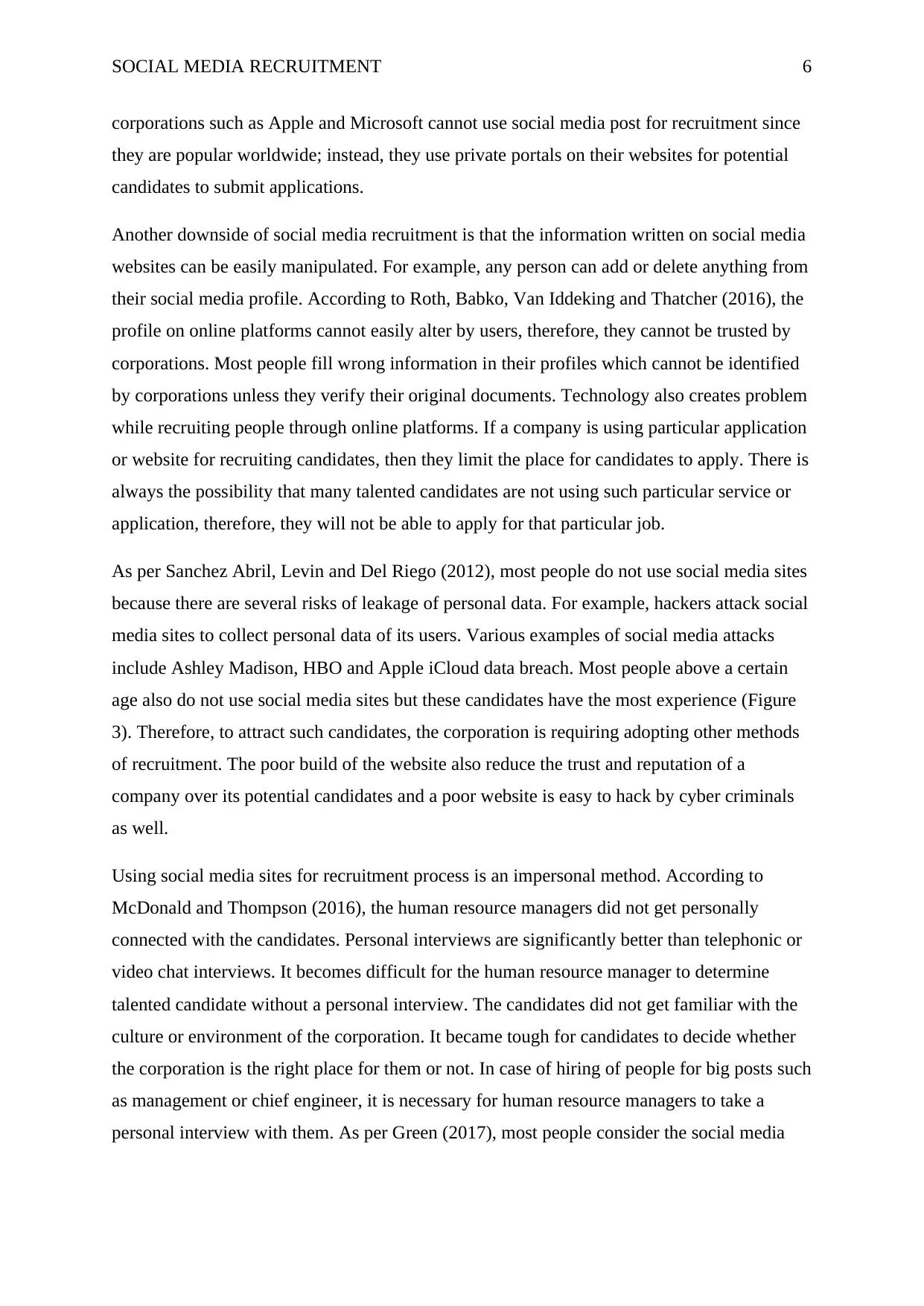
SOCIAL MEDIA RECRUITMENT 6
corporations such as Apple and Microsoft cannot use social media post for recruitment since
they are popular worldwide; instead, they use private portals on their websites for potential
candidates to submit applications.
Another downside of social media recruitment is that the information written on social media
websites can be easily manipulated. For example, any person can add or delete anything from
their social media profile. According to Roth, Babko, Van Iddeking and Thatcher (2016), the
profile on online platforms cannot easily alter by users, therefore, they cannot be trusted by
corporations. Most people fill wrong information in their profiles which cannot be identified
by corporations unless they verify their original documents. Technology also creates problem
while recruiting people through online platforms. If a company is using particular application
or website for recruiting candidates, then they limit the place for candidates to apply. There is
always the possibility that many talented candidates are not using such particular service or
application, therefore, they will not be able to apply for that particular job.
As per Sanchez Abril, Levin and Del Riego (2012), most people do not use social media sites
because there are several risks of leakage of personal data. For example, hackers attack social
media sites to collect personal data of its users. Various examples of social media attacks
include Ashley Madison, HBO and Apple iCloud data breach. Most people above a certain
age also do not use social media sites but these candidates have the most experience (Figure
3). Therefore, to attract such candidates, the corporation is requiring adopting other methods
of recruitment. The poor build of the website also reduce the trust and reputation of a
company over its potential candidates and a poor website is easy to hack by cyber criminals
as well.
Using social media sites for recruitment process is an impersonal method. According to
McDonald and Thompson (2016), the human resource managers did not get personally
connected with the candidates. Personal interviews are significantly better than telephonic or
video chat interviews. It becomes difficult for the human resource manager to determine
talented candidate without a personal interview. The candidates did not get familiar with the
culture or environment of the corporation. It became tough for candidates to decide whether
the corporation is the right place for them or not. In case of hiring of people for big posts such
as management or chief engineer, it is necessary for human resource managers to take a
personal interview with them. As per Green (2017), most people consider the social media
corporations such as Apple and Microsoft cannot use social media post for recruitment since
they are popular worldwide; instead, they use private portals on their websites for potential
candidates to submit applications.
Another downside of social media recruitment is that the information written on social media
websites can be easily manipulated. For example, any person can add or delete anything from
their social media profile. According to Roth, Babko, Van Iddeking and Thatcher (2016), the
profile on online platforms cannot easily alter by users, therefore, they cannot be trusted by
corporations. Most people fill wrong information in their profiles which cannot be identified
by corporations unless they verify their original documents. Technology also creates problem
while recruiting people through online platforms. If a company is using particular application
or website for recruiting candidates, then they limit the place for candidates to apply. There is
always the possibility that many talented candidates are not using such particular service or
application, therefore, they will not be able to apply for that particular job.
As per Sanchez Abril, Levin and Del Riego (2012), most people do not use social media sites
because there are several risks of leakage of personal data. For example, hackers attack social
media sites to collect personal data of its users. Various examples of social media attacks
include Ashley Madison, HBO and Apple iCloud data breach. Most people above a certain
age also do not use social media sites but these candidates have the most experience (Figure
3). Therefore, to attract such candidates, the corporation is requiring adopting other methods
of recruitment. The poor build of the website also reduce the trust and reputation of a
company over its potential candidates and a poor website is easy to hack by cyber criminals
as well.
Using social media sites for recruitment process is an impersonal method. According to
McDonald and Thompson (2016), the human resource managers did not get personally
connected with the candidates. Personal interviews are significantly better than telephonic or
video chat interviews. It becomes difficult for the human resource manager to determine
talented candidate without a personal interview. The candidates did not get familiar with the
culture or environment of the corporation. It became tough for candidates to decide whether
the corporation is the right place for them or not. In case of hiring of people for big posts such
as management or chief engineer, it is necessary for human resource managers to take a
personal interview with them. As per Green (2017), most people consider the social media
Paraphrase This Document
Need a fresh take? Get an instant paraphrase of this document with our AI Paraphraser
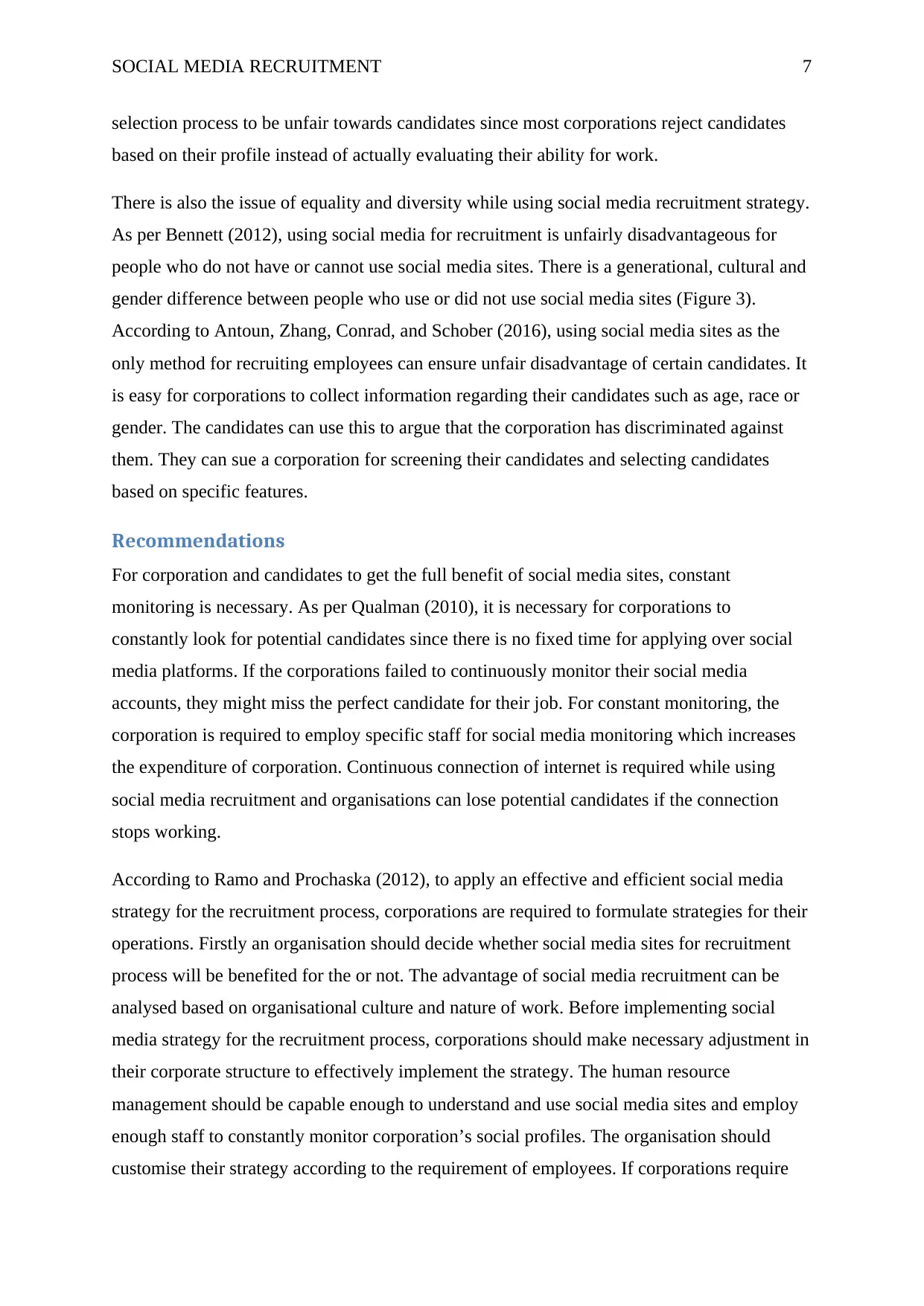
SOCIAL MEDIA RECRUITMENT 7
selection process to be unfair towards candidates since most corporations reject candidates
based on their profile instead of actually evaluating their ability for work.
There is also the issue of equality and diversity while using social media recruitment strategy.
As per Bennett (2012), using social media for recruitment is unfairly disadvantageous for
people who do not have or cannot use social media sites. There is a generational, cultural and
gender difference between people who use or did not use social media sites (Figure 3).
According to Antoun, Zhang, Conrad, and Schober (2016), using social media sites as the
only method for recruiting employees can ensure unfair disadvantage of certain candidates. It
is easy for corporations to collect information regarding their candidates such as age, race or
gender. The candidates can use this to argue that the corporation has discriminated against
them. They can sue a corporation for screening their candidates and selecting candidates
based on specific features.
Recommendations
For corporation and candidates to get the full benefit of social media sites, constant
monitoring is necessary. As per Qualman (2010), it is necessary for corporations to
constantly look for potential candidates since there is no fixed time for applying over social
media platforms. If the corporations failed to continuously monitor their social media
accounts, they might miss the perfect candidate for their job. For constant monitoring, the
corporation is required to employ specific staff for social media monitoring which increases
the expenditure of corporation. Continuous connection of internet is required while using
social media recruitment and organisations can lose potential candidates if the connection
stops working.
According to Ramo and Prochaska (2012), to apply an effective and efficient social media
strategy for the recruitment process, corporations are required to formulate strategies for their
operations. Firstly an organisation should decide whether social media sites for recruitment
process will be benefited for the or not. The advantage of social media recruitment can be
analysed based on organisational culture and nature of work. Before implementing social
media strategy for the recruitment process, corporations should make necessary adjustment in
their corporate structure to effectively implement the strategy. The human resource
management should be capable enough to understand and use social media sites and employ
enough staff to constantly monitor corporation’s social profiles. The organisation should
customise their strategy according to the requirement of employees. If corporations require
selection process to be unfair towards candidates since most corporations reject candidates
based on their profile instead of actually evaluating their ability for work.
There is also the issue of equality and diversity while using social media recruitment strategy.
As per Bennett (2012), using social media for recruitment is unfairly disadvantageous for
people who do not have or cannot use social media sites. There is a generational, cultural and
gender difference between people who use or did not use social media sites (Figure 3).
According to Antoun, Zhang, Conrad, and Schober (2016), using social media sites as the
only method for recruiting employees can ensure unfair disadvantage of certain candidates. It
is easy for corporations to collect information regarding their candidates such as age, race or
gender. The candidates can use this to argue that the corporation has discriminated against
them. They can sue a corporation for screening their candidates and selecting candidates
based on specific features.
Recommendations
For corporation and candidates to get the full benefit of social media sites, constant
monitoring is necessary. As per Qualman (2010), it is necessary for corporations to
constantly look for potential candidates since there is no fixed time for applying over social
media platforms. If the corporations failed to continuously monitor their social media
accounts, they might miss the perfect candidate for their job. For constant monitoring, the
corporation is required to employ specific staff for social media monitoring which increases
the expenditure of corporation. Continuous connection of internet is required while using
social media recruitment and organisations can lose potential candidates if the connection
stops working.
According to Ramo and Prochaska (2012), to apply an effective and efficient social media
strategy for the recruitment process, corporations are required to formulate strategies for their
operations. Firstly an organisation should decide whether social media sites for recruitment
process will be benefited for the or not. The advantage of social media recruitment can be
analysed based on organisational culture and nature of work. Before implementing social
media strategy for the recruitment process, corporations should make necessary adjustment in
their corporate structure to effectively implement the strategy. The human resource
management should be capable enough to understand and use social media sites and employ
enough staff to constantly monitor corporation’s social profiles. The organisation should
customise their strategy according to the requirement of employees. If corporations require
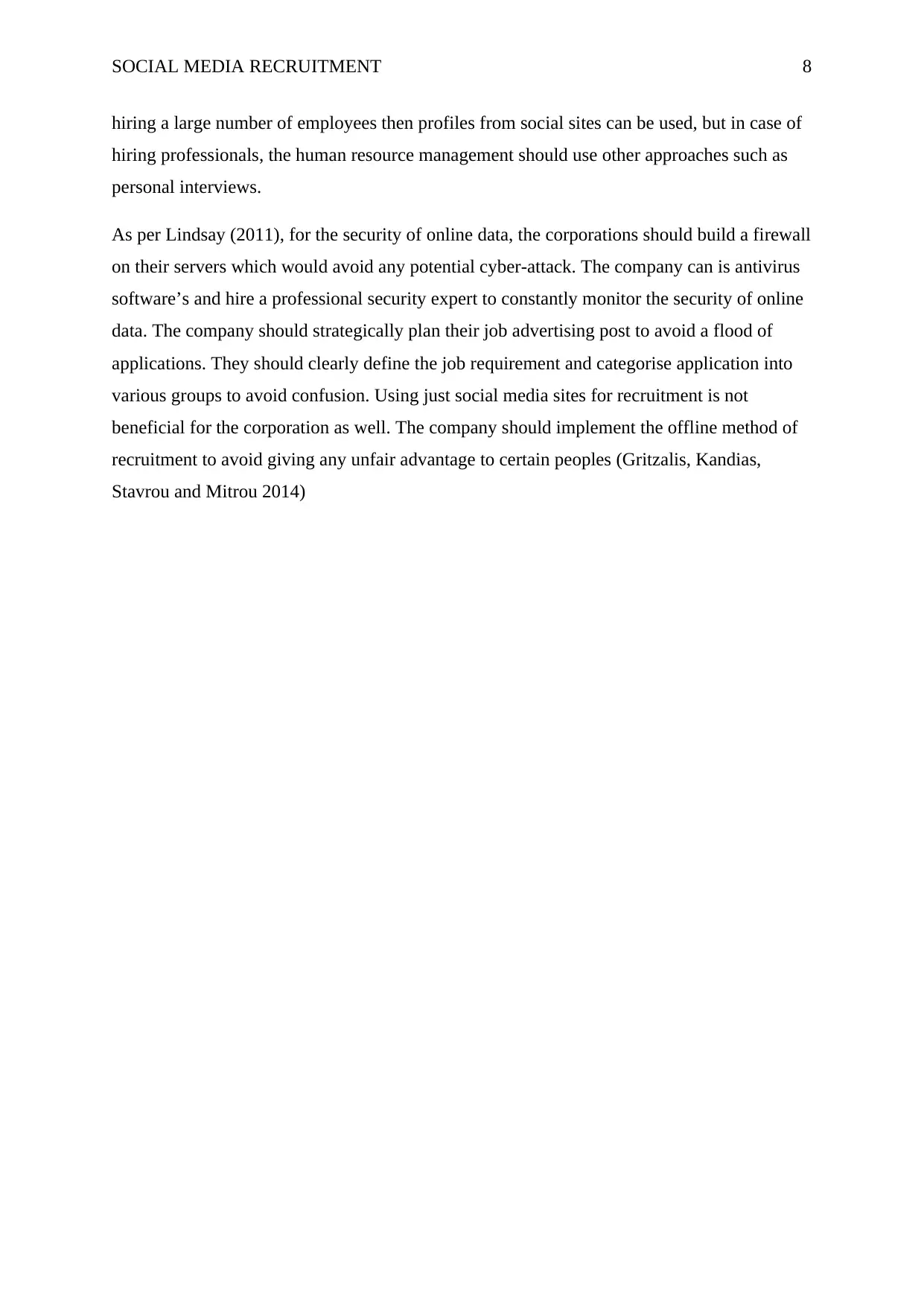
SOCIAL MEDIA RECRUITMENT 8
hiring a large number of employees then profiles from social sites can be used, but in case of
hiring professionals, the human resource management should use other approaches such as
personal interviews.
As per Lindsay (2011), for the security of online data, the corporations should build a firewall
on their servers which would avoid any potential cyber-attack. The company can is antivirus
software’s and hire a professional security expert to constantly monitor the security of online
data. The company should strategically plan their job advertising post to avoid a flood of
applications. They should clearly define the job requirement and categorise application into
various groups to avoid confusion. Using just social media sites for recruitment is not
beneficial for the corporation as well. The company should implement the offline method of
recruitment to avoid giving any unfair advantage to certain peoples (Gritzalis, Kandias,
Stavrou and Mitrou 2014)
hiring a large number of employees then profiles from social sites can be used, but in case of
hiring professionals, the human resource management should use other approaches such as
personal interviews.
As per Lindsay (2011), for the security of online data, the corporations should build a firewall
on their servers which would avoid any potential cyber-attack. The company can is antivirus
software’s and hire a professional security expert to constantly monitor the security of online
data. The company should strategically plan their job advertising post to avoid a flood of
applications. They should clearly define the job requirement and categorise application into
various groups to avoid confusion. Using just social media sites for recruitment is not
beneficial for the corporation as well. The company should implement the offline method of
recruitment to avoid giving any unfair advantage to certain peoples (Gritzalis, Kandias,
Stavrou and Mitrou 2014)
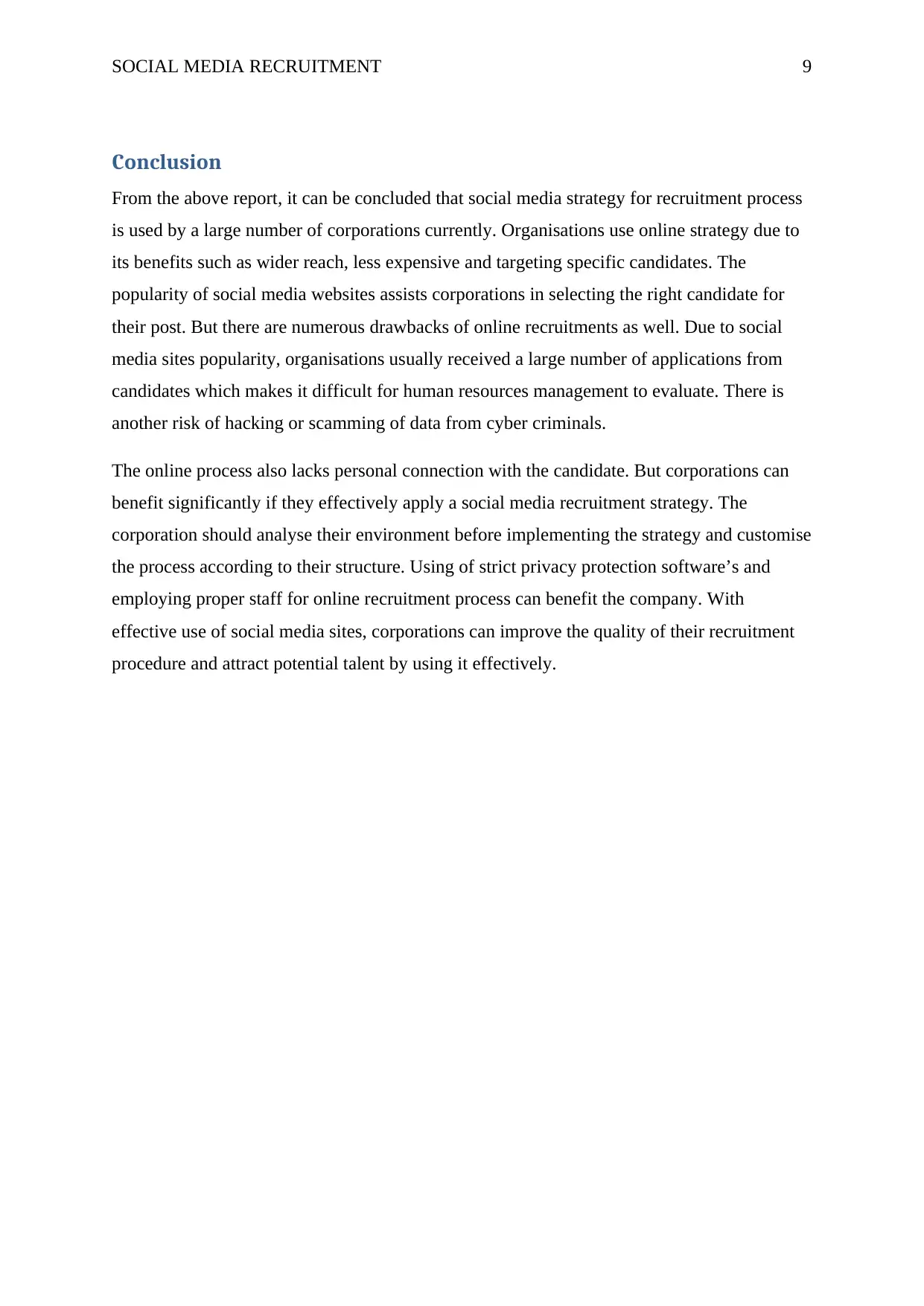
SOCIAL MEDIA RECRUITMENT 9
Conclusion
From the above report, it can be concluded that social media strategy for recruitment process
is used by a large number of corporations currently. Organisations use online strategy due to
its benefits such as wider reach, less expensive and targeting specific candidates. The
popularity of social media websites assists corporations in selecting the right candidate for
their post. But there are numerous drawbacks of online recruitments as well. Due to social
media sites popularity, organisations usually received a large number of applications from
candidates which makes it difficult for human resources management to evaluate. There is
another risk of hacking or scamming of data from cyber criminals.
The online process also lacks personal connection with the candidate. But corporations can
benefit significantly if they effectively apply a social media recruitment strategy. The
corporation should analyse their environment before implementing the strategy and customise
the process according to their structure. Using of strict privacy protection software’s and
employing proper staff for online recruitment process can benefit the company. With
effective use of social media sites, corporations can improve the quality of their recruitment
procedure and attract potential talent by using it effectively.
Conclusion
From the above report, it can be concluded that social media strategy for recruitment process
is used by a large number of corporations currently. Organisations use online strategy due to
its benefits such as wider reach, less expensive and targeting specific candidates. The
popularity of social media websites assists corporations in selecting the right candidate for
their post. But there are numerous drawbacks of online recruitments as well. Due to social
media sites popularity, organisations usually received a large number of applications from
candidates which makes it difficult for human resources management to evaluate. There is
another risk of hacking or scamming of data from cyber criminals.
The online process also lacks personal connection with the candidate. But corporations can
benefit significantly if they effectively apply a social media recruitment strategy. The
corporation should analyse their environment before implementing the strategy and customise
the process according to their structure. Using of strict privacy protection software’s and
employing proper staff for online recruitment process can benefit the company. With
effective use of social media sites, corporations can improve the quality of their recruitment
procedure and attract potential talent by using it effectively.
Secure Best Marks with AI Grader
Need help grading? Try our AI Grader for instant feedback on your assignments.
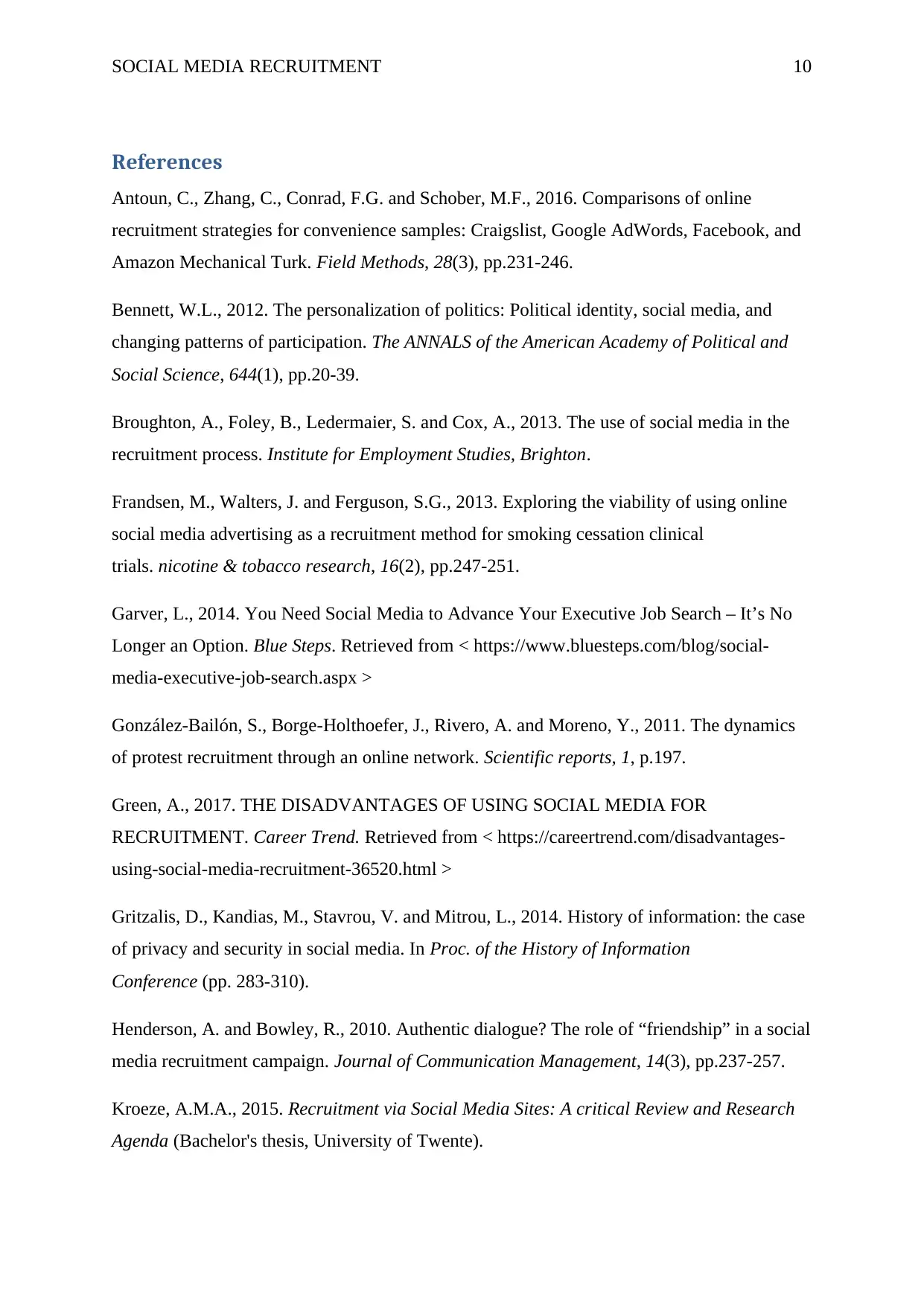
SOCIAL MEDIA RECRUITMENT 10
References
Antoun, C., Zhang, C., Conrad, F.G. and Schober, M.F., 2016. Comparisons of online
recruitment strategies for convenience samples: Craigslist, Google AdWords, Facebook, and
Amazon Mechanical Turk. Field Methods, 28(3), pp.231-246.
Bennett, W.L., 2012. The personalization of politics: Political identity, social media, and
changing patterns of participation. The ANNALS of the American Academy of Political and
Social Science, 644(1), pp.20-39.
Broughton, A., Foley, B., Ledermaier, S. and Cox, A., 2013. The use of social media in the
recruitment process. Institute for Employment Studies, Brighton.
Frandsen, M., Walters, J. and Ferguson, S.G., 2013. Exploring the viability of using online
social media advertising as a recruitment method for smoking cessation clinical
trials. nicotine & tobacco research, 16(2), pp.247-251.
Garver, L., 2014. You Need Social Media to Advance Your Executive Job Search – It’s No
Longer an Option. Blue Steps. Retrieved from < https://www.bluesteps.com/blog/social-
media-executive-job-search.aspx >
González-Bailón, S., Borge-Holthoefer, J., Rivero, A. and Moreno, Y., 2011. The dynamics
of protest recruitment through an online network. Scientific reports, 1, p.197.
Green, A., 2017. THE DISADVANTAGES OF USING SOCIAL MEDIA FOR
RECRUITMENT. Career Trend. Retrieved from < https://careertrend.com/disadvantages-
using-social-media-recruitment-36520.html >
Gritzalis, D., Kandias, M., Stavrou, V. and Mitrou, L., 2014. History of information: the case
of privacy and security in social media. In Proc. of the History of Information
Conference (pp. 283-310).
Henderson, A. and Bowley, R., 2010. Authentic dialogue? The role of “friendship” in a social
media recruitment campaign. Journal of Communication Management, 14(3), pp.237-257.
Kroeze, A.M.A., 2015. Recruitment via Social Media Sites: A critical Review and Research
Agenda (Bachelor's thesis, University of Twente).
References
Antoun, C., Zhang, C., Conrad, F.G. and Schober, M.F., 2016. Comparisons of online
recruitment strategies for convenience samples: Craigslist, Google AdWords, Facebook, and
Amazon Mechanical Turk. Field Methods, 28(3), pp.231-246.
Bennett, W.L., 2012. The personalization of politics: Political identity, social media, and
changing patterns of participation. The ANNALS of the American Academy of Political and
Social Science, 644(1), pp.20-39.
Broughton, A., Foley, B., Ledermaier, S. and Cox, A., 2013. The use of social media in the
recruitment process. Institute for Employment Studies, Brighton.
Frandsen, M., Walters, J. and Ferguson, S.G., 2013. Exploring the viability of using online
social media advertising as a recruitment method for smoking cessation clinical
trials. nicotine & tobacco research, 16(2), pp.247-251.
Garver, L., 2014. You Need Social Media to Advance Your Executive Job Search – It’s No
Longer an Option. Blue Steps. Retrieved from < https://www.bluesteps.com/blog/social-
media-executive-job-search.aspx >
González-Bailón, S., Borge-Holthoefer, J., Rivero, A. and Moreno, Y., 2011. The dynamics
of protest recruitment through an online network. Scientific reports, 1, p.197.
Green, A., 2017. THE DISADVANTAGES OF USING SOCIAL MEDIA FOR
RECRUITMENT. Career Trend. Retrieved from < https://careertrend.com/disadvantages-
using-social-media-recruitment-36520.html >
Gritzalis, D., Kandias, M., Stavrou, V. and Mitrou, L., 2014. History of information: the case
of privacy and security in social media. In Proc. of the History of Information
Conference (pp. 283-310).
Henderson, A. and Bowley, R., 2010. Authentic dialogue? The role of “friendship” in a social
media recruitment campaign. Journal of Communication Management, 14(3), pp.237-257.
Kroeze, A.M.A., 2015. Recruitment via Social Media Sites: A critical Review and Research
Agenda (Bachelor's thesis, University of Twente).
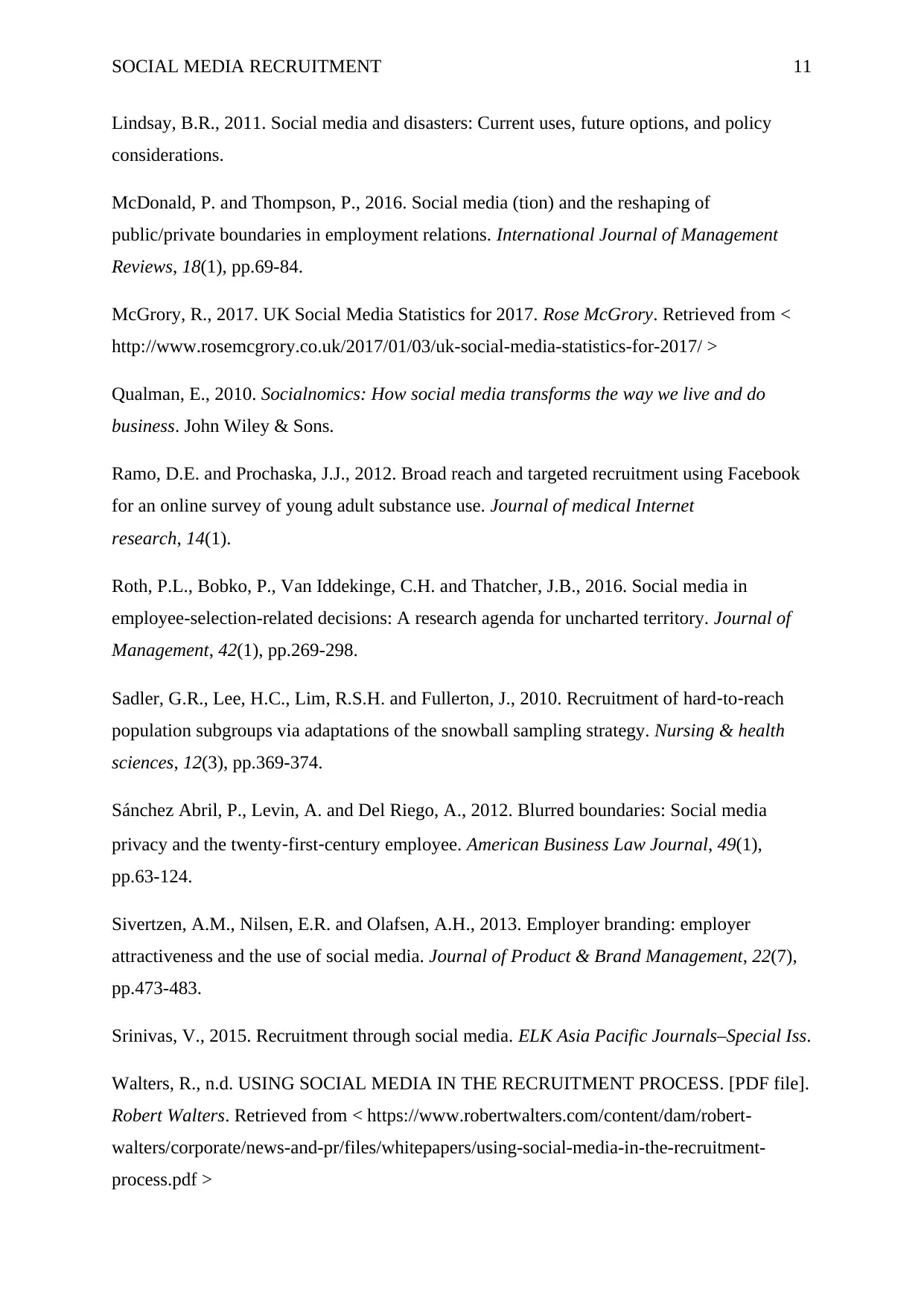
SOCIAL MEDIA RECRUITMENT 11
Lindsay, B.R., 2011. Social media and disasters: Current uses, future options, and policy
considerations.
McDonald, P. and Thompson, P., 2016. Social media (tion) and the reshaping of
public/private boundaries in employment relations. International Journal of Management
Reviews, 18(1), pp.69-84.
McGrory, R., 2017. UK Social Media Statistics for 2017. Rose McGrory. Retrieved from <
http://www.rosemcgrory.co.uk/2017/01/03/uk-social-media-statistics-for-2017/ >
Qualman, E., 2010. Socialnomics: How social media transforms the way we live and do
business. John Wiley & Sons.
Ramo, D.E. and Prochaska, J.J., 2012. Broad reach and targeted recruitment using Facebook
for an online survey of young adult substance use. Journal of medical Internet
research, 14(1).
Roth, P.L., Bobko, P., Van Iddekinge, C.H. and Thatcher, J.B., 2016. Social media in
employee-selection-related decisions: A research agenda for uncharted territory. Journal of
Management, 42(1), pp.269-298.
Sadler, G.R., Lee, H.C., Lim, R.S.H. and Fullerton, J., 2010. Recruitment of hard‐to‐reach
population subgroups via adaptations of the snowball sampling strategy. Nursing & health
sciences, 12(3), pp.369-374.
Sánchez Abril, P., Levin, A. and Del Riego, A., 2012. Blurred boundaries: Social media
privacy and the twenty‐first‐century employee. American Business Law Journal, 49(1),
pp.63-124.
Sivertzen, A.M., Nilsen, E.R. and Olafsen, A.H., 2013. Employer branding: employer
attractiveness and the use of social media. Journal of Product & Brand Management, 22(7),
pp.473-483.
Srinivas, V., 2015. Recruitment through social media. ELK Asia Pacific Journals–Special Iss.
Walters, R., n.d. USING SOCIAL MEDIA IN THE RECRUITMENT PROCESS. [PDF file].
Robert Walters. Retrieved from < https://www.robertwalters.com/content/dam/robert-
walters/corporate/news-and-pr/files/whitepapers/using-social-media-in-the-recruitment-
process.pdf >
Lindsay, B.R., 2011. Social media and disasters: Current uses, future options, and policy
considerations.
McDonald, P. and Thompson, P., 2016. Social media (tion) and the reshaping of
public/private boundaries in employment relations. International Journal of Management
Reviews, 18(1), pp.69-84.
McGrory, R., 2017. UK Social Media Statistics for 2017. Rose McGrory. Retrieved from <
http://www.rosemcgrory.co.uk/2017/01/03/uk-social-media-statistics-for-2017/ >
Qualman, E., 2010. Socialnomics: How social media transforms the way we live and do
business. John Wiley & Sons.
Ramo, D.E. and Prochaska, J.J., 2012. Broad reach and targeted recruitment using Facebook
for an online survey of young adult substance use. Journal of medical Internet
research, 14(1).
Roth, P.L., Bobko, P., Van Iddekinge, C.H. and Thatcher, J.B., 2016. Social media in
employee-selection-related decisions: A research agenda for uncharted territory. Journal of
Management, 42(1), pp.269-298.
Sadler, G.R., Lee, H.C., Lim, R.S.H. and Fullerton, J., 2010. Recruitment of hard‐to‐reach
population subgroups via adaptations of the snowball sampling strategy. Nursing & health
sciences, 12(3), pp.369-374.
Sánchez Abril, P., Levin, A. and Del Riego, A., 2012. Blurred boundaries: Social media
privacy and the twenty‐first‐century employee. American Business Law Journal, 49(1),
pp.63-124.
Sivertzen, A.M., Nilsen, E.R. and Olafsen, A.H., 2013. Employer branding: employer
attractiveness and the use of social media. Journal of Product & Brand Management, 22(7),
pp.473-483.
Srinivas, V., 2015. Recruitment through social media. ELK Asia Pacific Journals–Special Iss.
Walters, R., n.d. USING SOCIAL MEDIA IN THE RECRUITMENT PROCESS. [PDF file].
Robert Walters. Retrieved from < https://www.robertwalters.com/content/dam/robert-
walters/corporate/news-and-pr/files/whitepapers/using-social-media-in-the-recruitment-
process.pdf >
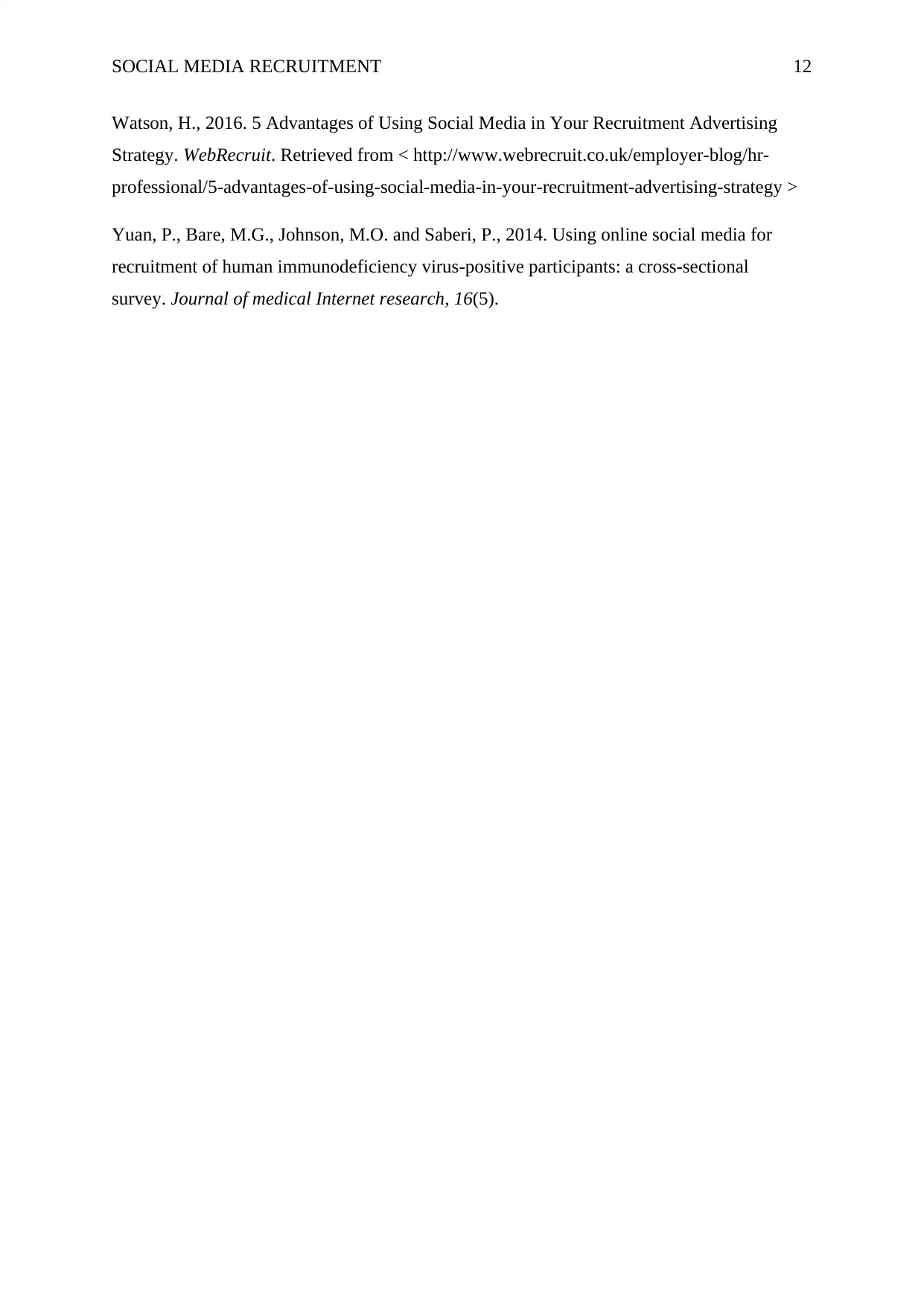
SOCIAL MEDIA RECRUITMENT 12
Watson, H., 2016. 5 Advantages of Using Social Media in Your Recruitment Advertising
Strategy. WebRecruit. Retrieved from < http://www.webrecruit.co.uk/employer-blog/hr-
professional/5-advantages-of-using-social-media-in-your-recruitment-advertising-strategy >
Yuan, P., Bare, M.G., Johnson, M.O. and Saberi, P., 2014. Using online social media for
recruitment of human immunodeficiency virus-positive participants: a cross-sectional
survey. Journal of medical Internet research, 16(5).
Watson, H., 2016. 5 Advantages of Using Social Media in Your Recruitment Advertising
Strategy. WebRecruit. Retrieved from < http://www.webrecruit.co.uk/employer-blog/hr-
professional/5-advantages-of-using-social-media-in-your-recruitment-advertising-strategy >
Yuan, P., Bare, M.G., Johnson, M.O. and Saberi, P., 2014. Using online social media for
recruitment of human immunodeficiency virus-positive participants: a cross-sectional
survey. Journal of medical Internet research, 16(5).
Paraphrase This Document
Need a fresh take? Get an instant paraphrase of this document with our AI Paraphraser
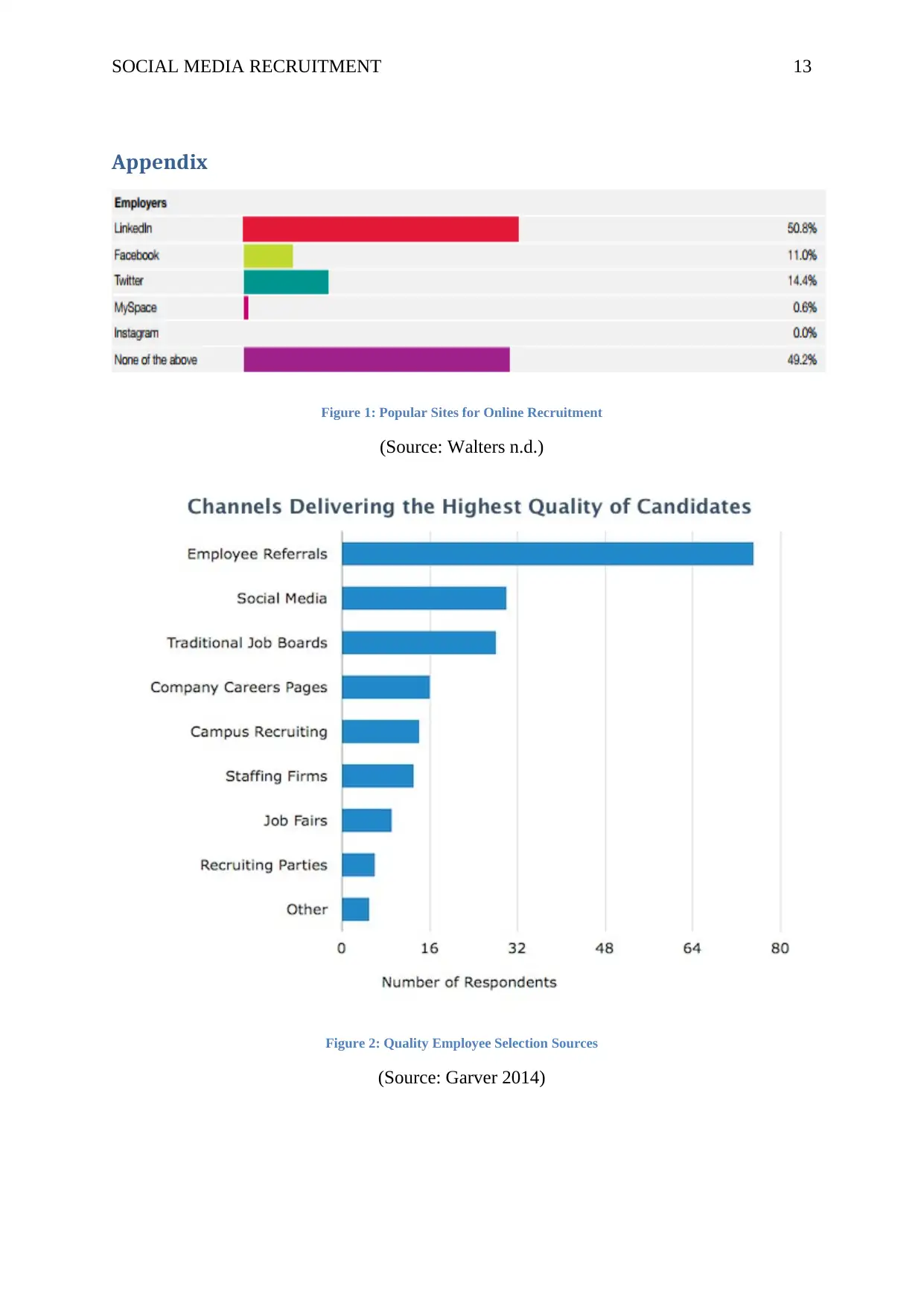
SOCIAL MEDIA RECRUITMENT 13
Appendix
Figure 1: Popular Sites for Online Recruitment
(Source: Walters n.d.)
Figure 2: Quality Employee Selection Sources
(Source: Garver 2014)
Appendix
Figure 1: Popular Sites for Online Recruitment
(Source: Walters n.d.)
Figure 2: Quality Employee Selection Sources
(Source: Garver 2014)
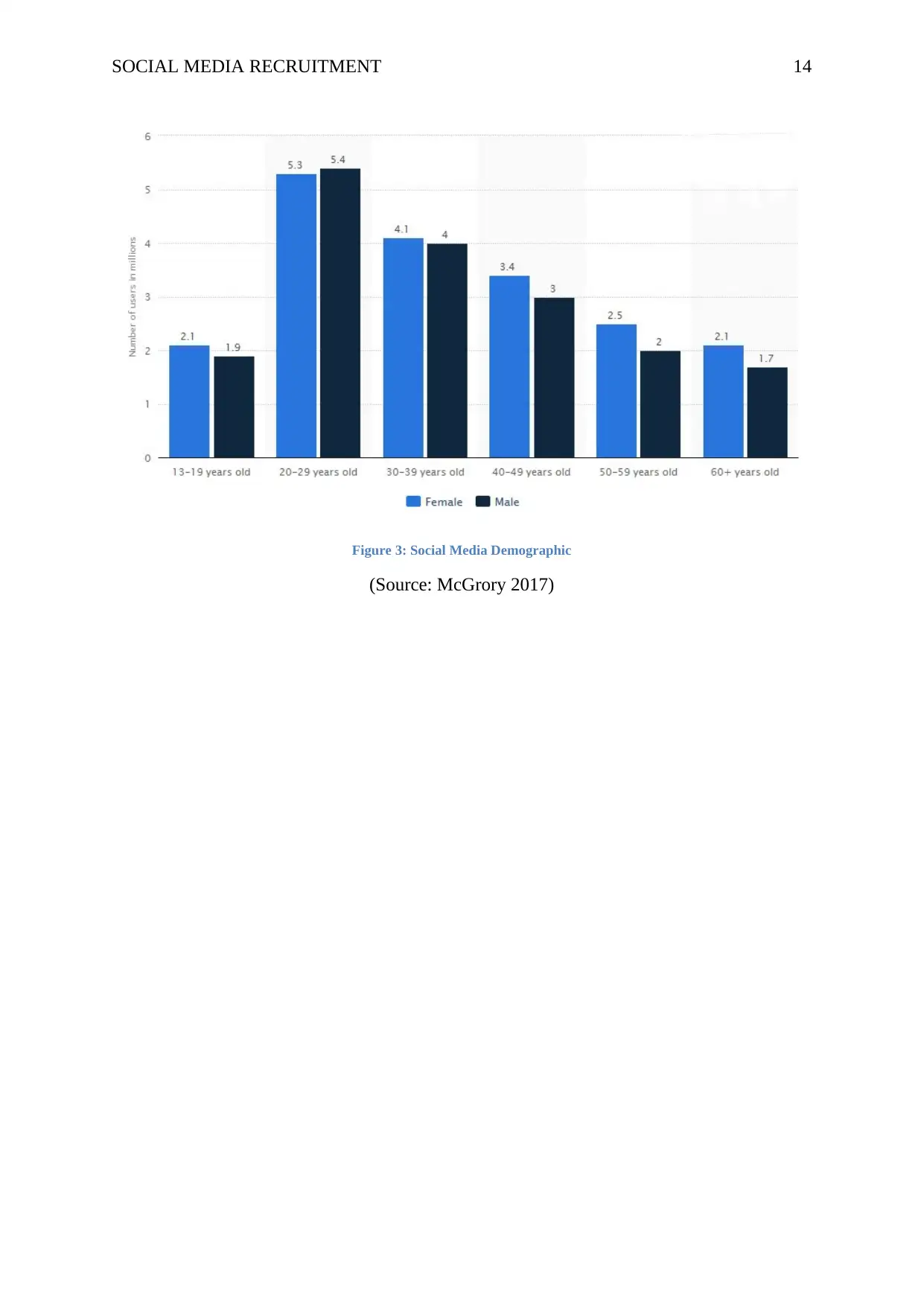
SOCIAL MEDIA RECRUITMENT 14
Figure 3: Social Media Demographic
(Source: McGrory 2017)
Figure 3: Social Media Demographic
(Source: McGrory 2017)
1 out of 15
Related Documents
Your All-in-One AI-Powered Toolkit for Academic Success.
+13062052269
info@desklib.com
Available 24*7 on WhatsApp / Email
![[object Object]](/_next/static/media/star-bottom.7253800d.svg)
Unlock your academic potential
© 2024 | Zucol Services PVT LTD | All rights reserved.





